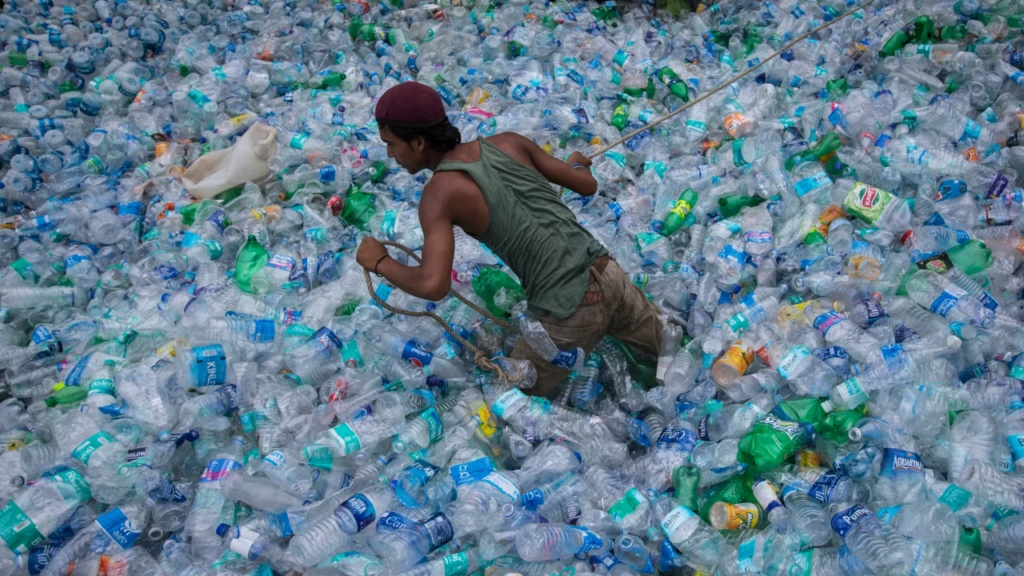In a groundbreaking step toward a more sustainable future, scientists have developed a biodegradable plastic alternative made from seaweed. This innovative material could transform industries, reduce plastic pollution, and offer a renewable solution to one of the planet’s most pressing environmental challenges. With plastic waste clogging oceans, landfills, and even our food chains, this seaweed-based alternative is a beacon of hope for a cleaner, greener world.

The Plastic Pollution Crisis
Plastic is everywhere. From grocery bags to water bottles, it’s cheap, durable, and convenient. But these qualities come at a cost. Traditional plastics, made from petroleum, take hundreds of years to break down. They pile up in landfills, float in oceans, and break into tiny microplastics that harm wildlife and humans alike. According to recent studies, over 8 million metric tons of plastic enter the oceans every year, threatening marine life and ecosystems.
The search for sustainable alternatives has been ongoing for decades. While recycling helps, only about 9% of all plastic ever produced has been recycled. Most ends up incinerated or discarded, contributing to pollution and greenhouse gas emissions. Scientists, environmentalists, and policymakers have long sought a material that matches plastic’s versatility but doesn’t harm the planet. Enter seaweed—a humble, abundant resource that could change the game.
Why Seaweed?
Seaweed is a type of algae that grows in oceans and rivers. It’s renewable, fast-growing, and doesn’t require land, freshwater, or fertilizers to thrive. Unlike crops like corn or sugarcane, which are sometimes used for bioplastics, seaweed doesn’t compete with food production. It also absorbs carbon dioxide as it grows, helping to combat climate change. These qualities make seaweed an ideal candidate for sustainable materials.
The idea of using seaweed for biodegradable plastics isn’t entirely new, but recent advancements have brought it closer to reality. Researchers from institutions around the world, including universities and biotech companies, have been experimenting with seaweed’s natural polymers—molecules that can be shaped into flexible, durable materials. The result is a plastic-like substance that’s not only biodegradable but also safe for the environment.

How It Works
The process begins with harvesting seaweed, which is abundant in coastal regions. Scientists extract polysaccharides, such as alginate and carrageenan, from the seaweed. These natural compounds are then processed into films, coatings, or molded shapes that mimic the properties of plastic. The material can be used for packaging, bags, straws, and even medical products like sutures.
What sets this seaweed-based material apart is its ability to break down naturally. Unlike traditional plastics, which linger for centuries, seaweed plastic decomposes in soil or water within weeks to months, depending on the formulation. Some versions are even edible, opening up possibilities for food packaging that disappears without a trace. This biodegradability ensures that even if the material ends up in the environment, it won’t contribute to long-term pollution.
A Game-Changer for Industries
The potential applications for seaweed-based plastics are vast. Single-use plastics, like straws, cutlery, and food packaging, are a prime target. These items are often used for minutes but persist in the environment for decades. Replacing them with biodegradable alternatives could significantly reduce waste. Retailers and food companies are already showing interest, as consumers demand eco-friendly options.
Beyond packaging, seaweed plastics could be used in agriculture for mulch films that naturally degrade in soil. In healthcare, they could create dissolvable medical implants or wound dressings. The material’s versatility makes it a strong contender to replace petroleum-based plastics in multiple sectors.
However, scaling up production is a challenge. While seaweed is abundant, creating a consistent supply chain and refining manufacturing processes will take time. Cost is another hurdle. Currently, seaweed-based plastics are more expensive than traditional plastics, but researchers are optimistic that prices will drop as technology improves and demand grows.

Environmental and Economic Benefits
The environmental benefits of seaweed plastics are clear. By reducing reliance on fossil fuels, they cut down on greenhouse gas emissions. Their biodegradability means less waste in landfills and oceans. Seaweed farming also supports coastal ecosystems by improving water quality and providing habitats for marine life.
Economically, seaweed-based plastics could create new opportunities. Seaweed farming is labor-intensive, offering jobs in coastal communities, especially in developing countries. Countries like Indonesia, the Philippines, and Chile, which are major seaweed producers, could become key players in this emerging industry. Small-scale farmers and cooperatives stand to benefit, as demand for seaweed grows.
Moreover, seaweed cultivation is a low-tech process that doesn’t require heavy machinery or chemicals. This accessibility makes it a viable option for regions with limited resources. As the industry expands, it could drive innovation in sustainable agriculture and manufacturing.
Challenges and the Road Ahead
While the potential is exciting, there are obstacles to overcome. One concern is ensuring that seaweed farming remains sustainable. Overharvesting or poorly managed farms could harm marine ecosystems. Researchers emphasize the need for responsible practices, such as rotating harvest areas and monitoring water quality.
Another challenge is consumer acceptance. Will people embrace seaweed-based products, especially if they cost more initially? Education and awareness campaigns will be key to highlighting the benefits. Governments and businesses can also play a role by offering incentives, such as subsidies for eco-friendly materials or bans on single-use plastics.
Regulatory approval is another hurdle. Before seaweed plastics can be widely used, especially in food or medical applications, they must meet strict safety standards. Researchers are working to ensure the materials are non-toxic and perform reliably in real-world conditions.
Despite these challenges, the momentum is building. Several startups and research groups are already producing seaweed-based products on a small scale. Governments are taking notice, with some offering grants to support sustainable innovation. As technology advances, the gap between seaweed plastics and traditional plastics will narrow, making them a viable option for mainstream use.
A Vision for the Future
The development of seaweed-based plastics is more than a scientific breakthrough—it’s a step toward rethinking how we produce and consume materials. Imagine a world where plastic bags dissolve harmlessly in the ocean, where food packaging nourishes the soil instead of polluting it. This vision is within reach, thanks to the ingenuity of scientists and the humble power of seaweed.
For consumers, the shift to seaweed plastics offers a chance to make a difference. Choosing products made from sustainable materials can drive demand and encourage companies to invest in green alternatives. For businesses, it’s an opportunity to innovate and meet the growing demand for eco-friendly solutions. For the planet, it’s a lifeline—a way to reduce the burden of plastic waste and protect ecosystems for future generations.
As research continues, the dream of a plastic-free future feels closer than ever. Seaweed, once overlooked, is proving to be a powerful ally in the fight against pollution. With collaboration between scientists, businesses, and communities, this biodegradable alternative could reshape industries and pave the way for a more sustainable world.
Must Read :- Gen Z Is Bringing Back 2000s Fashion Aesthetics Through Instagram Reels





